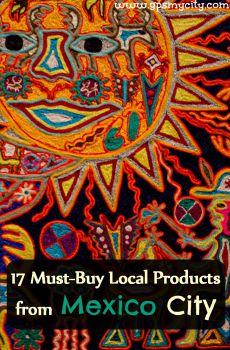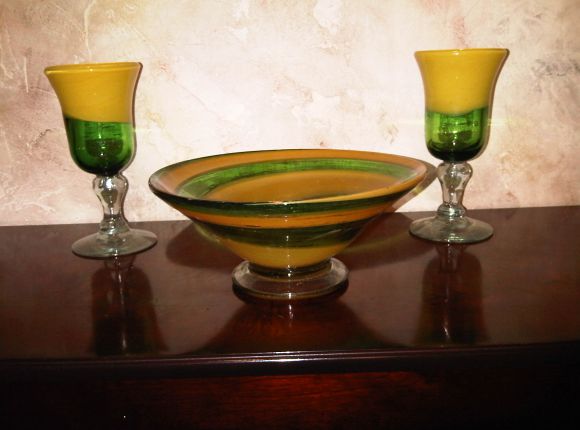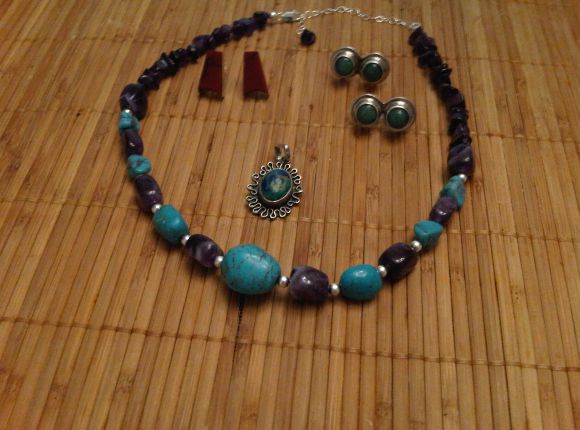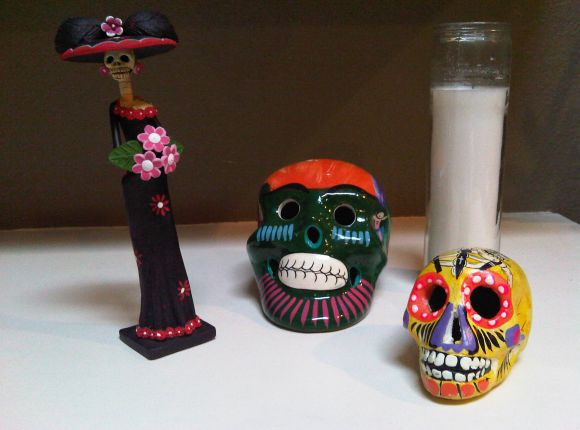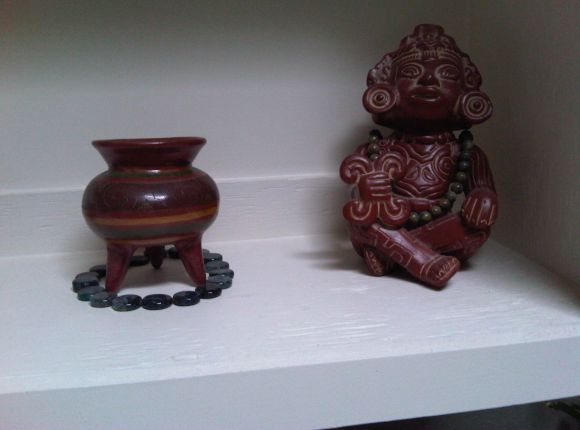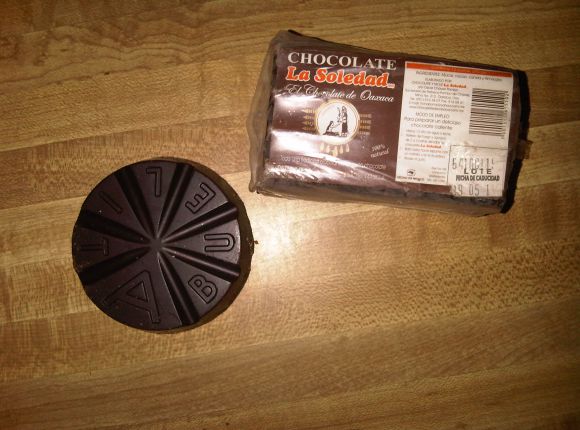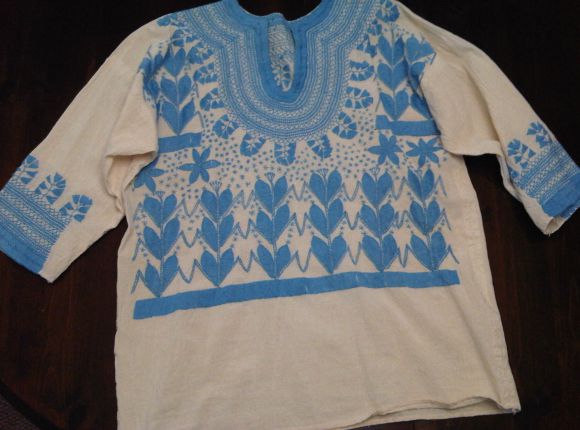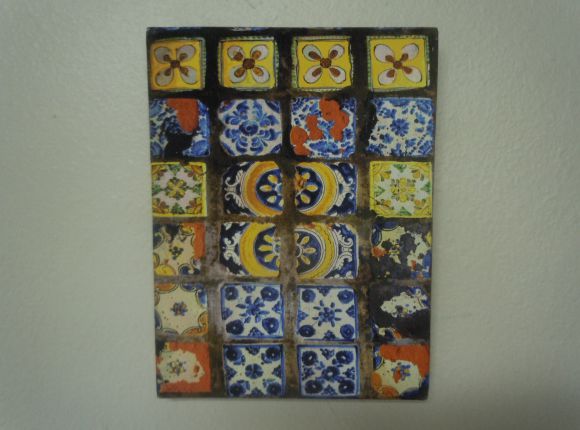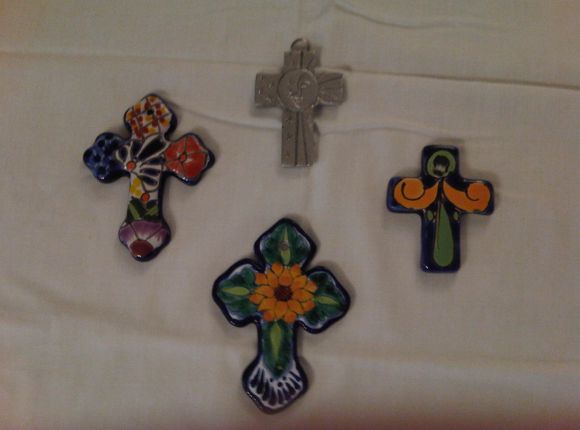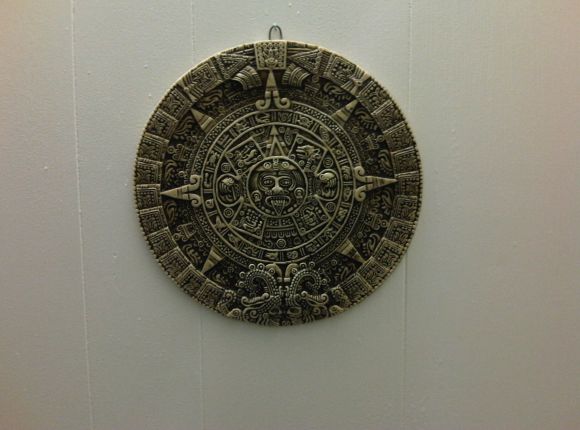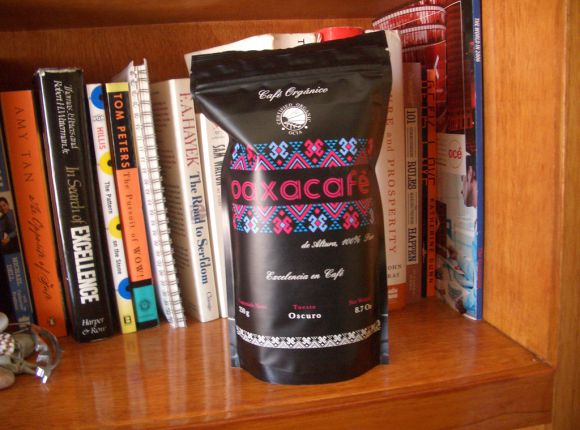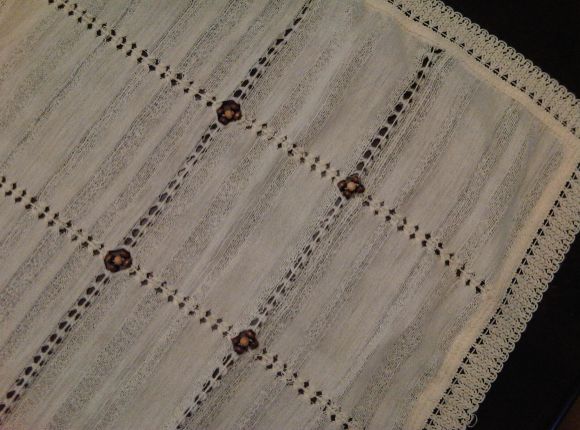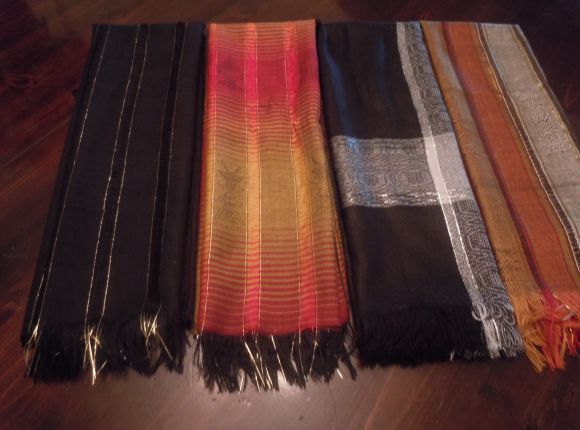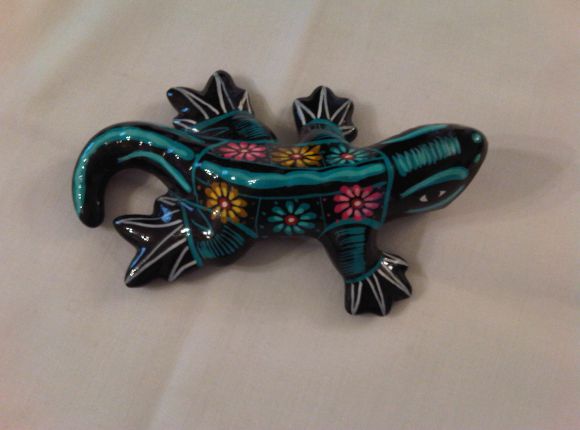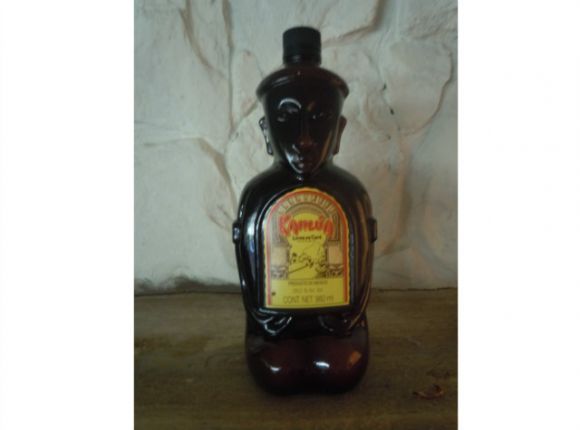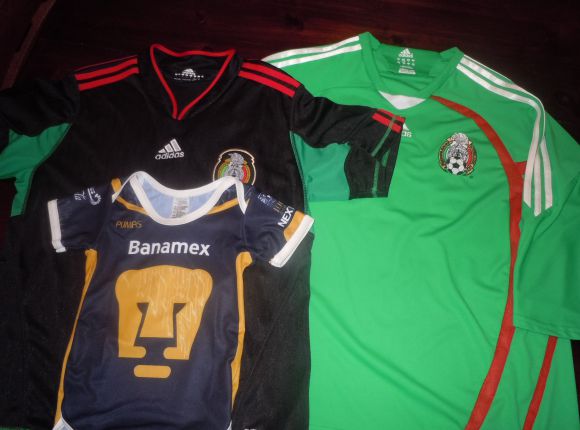1. Hand-Blown Glass
In Mexico, hand-blown and mouth-blown glass is a revered art form with a long history. No two pieces are ever the same, as each one is made individually. You can choose from a wide variety of hand-blown glass products, such as wine goblets, pitchers, tea glasses, serving bowls, shot glasses, margarita glasses, and many more. These utilitarian art pieces come in many different colors, including the popular, cobalt blue rimmed pieces. If you want more color, check out the confetti glass pieces, which feature several colors in fun patterns. Besides the serving and drink-ware choices, you can find hand-blown glass figurines, as well. Blown-glass products start around $15 for a single goblet.
Buy It on Amazon:
Offline reading and travel directions:
With GPSmyCity App you can read this article offline on your mobile device, use the embedded offline city map and GPS navigation, as well as create a self-guided walk to visit the venues featured in the article.
2. Jewelry
Mexico City shoppers can choose from a wide variety of earrings, necklaces, bracelets and more made by local artisans. The Mexican town of Taxco is famous for its silver work, while natural stones, such as turquoise, jade, amethyst and coral, are mined in many different parts of the Latin country. Pricing for these items will range depending upon the stone and setting. Some items begin at $20 USD, while others will cost hundreds of dollars. The trendy, yet bohemian, Condesa neighborhood of Mexico City features a wide variety of jewelry boutiques, handmade Mexican craft stores, silver shops and art galleries. Considered one of the most fashionable areas in Mexico City, Condesa is similar to Soho in New York City and the Latin Quarter of Paris, and it is popular with artists, students and young business people.
Offline reading and travel directions:
With GPSmyCity App you can read this article offline on your mobile device, use the embedded offline city map and GPS navigation, as well as create a self-guided walk to visit the venues featured in the article.
3. Día de los Muertos
Typically celebrated on November 1st each year, Día de los Muertos, is a popular Mexican holiday that focuses on remembering loved ones and friends that aren't there no more. On this day, Mexicans traditionally create altars in their homes or cemeteries that are decorated with candles, photos of deceased loved ones, colored paper hangings, pan de muerto (bread of the dead that is slightly sweet and features orange and anise flavors), different food and drinks that the deceased enjoyed, incense, salt and water. The other main decorative features are catrinas (miniature skeleton dolls dressed in clothing) and calaveras (miniature painted skulls). As this holiday is so close to the U.S. Halloween holiday, some of these Mexican decorations may serve a good addition to the celebration.
Buy It on Amazon:
Offline reading and travel directions:
With GPSmyCity App you can read this article offline on your mobile device, use the embedded offline city map and GPS navigation, as well as create a self-guided walk to visit the venues featured in the article.
4. Tribal Art
Mexico is home to many of the world’s most famous indigenous tribes, including the Mayans, Toltecs and Aztecs. In fact, just outside the city limits is the archaeological site of Teotihuacan, which features the Sun and Moon pyramids, the Temple of Quetzalcoatl and the Avenue of the Dead. Bring home a piece of history and culture with a locally-made copy of pre-Colombian art, such as a mask, statue or a pottery piece. Choose from a wide variety of mythological art pieces, such as a jaguar warrior statue or a mask depicting Quetzalcoatl, the Mesoamerican deity that is depicted as a feathered serpent. Other popular masks and statues include Atlaua, the water god, and Tlaloc, the god of rain, fertility and lightning.
5. Chocolate

Cultivated from a cacao tree, the first known culinary use of chocolate occurred in Mexico. In fact, the origination of the word “cacao” traces back to the Olmec tribe, which lived in the modern areas of Chiapas, Veracruz and Tabasco. All the ancient Mexican tribes incorporated chocolate in their daily lives and spiritual rituals, as cacao was known as the “gods’ food.” For example, the Mayas included chocolate in their elaborate wedding ceremonies, burial ceremonies and tombs, while the Aztecs took the cacao to new culinary, ritualistic and monetary levels. Modern Mexican chocolate typically refers to foamy chocolate drinks or cinnamon-scented round, flat disks of chocolate. It is one of the main ingredients in the famous Mexican dish, mole, as well.
Travelers can bring home a taste of Mexico with rich, Mexican hot chocolate mixes, blocks of hard chocolate for baking or drinks, or even chocolate bars flavored with chiles. Shop for your ideal Mexican chocolate, as well as other traditional Mexican sweets, such as cajeta, at Dulcería de Celaya. This sweet boutique was founded in 1874 and also has a branch in the La Roma neighborhood.
Where to find it:
Dulcería de Celaya
Address: 5 de Mayo 39
Operation Hours: Monday-Sunday: 10 am - 7 pm
Buy It on Amazon:
6. Tequila
Tequila is the traditional national drink of Mexico, and no trip to the country is complete without tasting it. This popular liquor is made from the Mexican-grown agave plant. Visitors can choose from a wide variety of tequila types, brands and price ranges, while in Mexico City. There are five main types of tequila, including Blanco or Plata (silver or white), Oro (gold), Reposado (rested), Añejo (aged or vintage) and Extra Añejo (extra aged). In Mexico, you can also find flavored tequilas and dessert tequilas, such as Dobel, which is creamy, sweet and coffee-flavored.
7. Huipil Clothing

Literally meaning “blouse” or “dress,” huipil clothing has been worn by indigenous Mexican women since pre-Hispanic times. This type of clothing actually originates in the Chiapas region, but you can now find it all over Mexico City in a wide variety of locations, from street markets to upscale boutiques. The traditional version is a loose-fitting, flowing white blouse or dress that features hand-embroidered flower patterns around the neckline. However, modern versions come in a wide variety of colors and patterns, and the more elaborate, the more expensive.
Visit the Mercado de la Merced near the Zócalo to find huipils for women, men and children. This popular market is the biggest in Mexico City, and it is housed in several modern buildings. You can find a wide variety of vendors that sell huipils, starting around $15 USD apiece. You can also find many other items sold at this market, including fresh Mexican chiles, rebozos, handmade jewelry and embroidered purses. Visit the nearby Templo Mayor, the ancient Aztec temple that is dedicated to the Aztec deities, Huitzilopochtli, the god of war, and Tlaloc, the god of rain and agriculture.
Where to find it:
Mercado de la Merced
Address: Rosario 156, east of the Zócalo, on Circunvalación between Adolfo Gurrión and General Anaya
Operation Hours: Monday-Sunday: 5:30 am - 6 pm
Buy It on Amazon:
8. Mexican Art

Mexico City was and is a hotspot for folk artists and painters, and many local art galleries featuring colorful originals and prints from the famed duo of Frida Kahlo and Diego Rivera, as well as modern artists. While you will want to check out some of the city’s most famous museums, such as the Diego Rivera Mural Museum, the Leon Trotsky Museum, and Frida Kahlo’s home in the Coyoacan area of Mexico City, you can bring home a masterpiece of your own as well. Check out the Jardin del Arte (Garden of Art), located between Sullivan and Villalongín near the popular Sullivan Park. This outdoor market occurs every Sunday behind the Monumento a la Madre (Monument to Mothers) in the San Rafael neighborhood. It features the works of between 350 and 400 different local artists, and is the largest outdoor art gallery in the world. Choose from a wide variety of art, from paintings of ink, oil and watercolors, etchings, sculptures and photography. Art prices range from $5 USD to $500 USD, depending on the size of the piece and the artist. The market is conveniently located near the center of Mexico City and is a sight that shouldn’t be missed on your trip.
Where to find it:
Jardin del Arte (Garden of Art)
Address: Calz. Manuel Villalongín 46, behind the Monumento a la Madre (Monument to Mothers)
Operation Hours: Monday - Wednesday: 7 am - 10:30 pm; Thursday: 6 am - 2 am;
Friday: 6 am - 4 am; Saturday: 6 am - 12 am; Sunday: 7 am - 10:30 pm
Buy It on Amazon:
9. Vanilla

Mexico is the birthplace of vanilla, and Mexican vanilla is considered to be the king of vanilla extracts. It is rich and smooth, and features a spicy element. The Totonac of the Veracruz are the first known cultivators of vanilla, which is actually the only edible fruit of the orchid flower. Bakers know that vanilla is one of the most essential cooking ingredients, and there is no substitute for it. Real vanilla is complex, as is made up of more than 250 components.
While you can find Mexican vanilla all over Mexico City, many tourist areas feature synthetic vanilla extract, which is not as good as the real thing. Shop like the locals and visit the upscale grocery store, Comercial Mexicana Sumesa in the Polanco neighborhood. It features a wide variety of vanillas, that range in price from $5 USD to $40 USD, depending on the brand and size. Choose from simple bottles, or elaborate containers that feature silver plated labels and may be considered works of art themselves. Bring home a bottle for yourself and your favorite baker friends.
Where to find it:
Comercial Mexicana Sumesa
Address: Virgilio no. 15 Col. Polanco Deleg. Miguel Hidalgo
Operation Hours: Monday-Sunday: 7 am - 10 pm
Buy It on Amazon:
10. Crosses

As Mexico is a devoutly Catholic nation, visitors will most likely visit many ornate cathedrals during their visits. Depictions of the Last Supper, as well as rosaries are found in most traditional Mexican homes, as well. Bring home a piece of Mexico with your own decorative cross. You can find Mexican crosses in a wide variety of sizes and materials, including hand-painted talavera, wood and metals. These beautiful wall hangings can brighten any room of the house, as well as add color and character to decorative space.
Visit the Mercado de La Ciudadela to find a Mexican cross that fits into your decorating theme. This quaint market is located on Balderas, between Reforma and Chapultepec. It features hundreds of authentic Mexican arts and crafts, including crosses that start around $10 USD. While you’re there, check out the Escuela Nacional de Artes, across the street from the market. It’s only a 10-minute walk from the Alemeda, and you can find other unique items there, including talavera pottery, tile-framed mirrors, hammocks and leather products. What's good is that whenever you need a break from all the shopping, you can have a picnic at the nearby scenic park.
Where to find it:
Mercado de La Ciudadela
Address: Balderas, between Reforma and Chapultepec
Operation Hours: Monday-Saturday: 10 am - 7 pm;
Sunday: 10 am - 6 pm
Buy It on Amazon:
11. Calendars

The Mayans and Aztecs contributed many things to modern society, such as their timekeeping devices. Calendars and the significance of the day and the astrological elements were extremely important to both of these indigenous cultures. In fact, calendars were also used as divination tools. In both indigenous cultures, babies were often named after the deity that ruled that day on the calendar. While visitors may not believe in these systems, they can still commemorate the year 2012 with a Mayan calendar.
You can also add to your outdoor patio art with an Aztec calendar. Choose from many different sizes, as well as plain clay versions or brightly-painted colored calendars. Get a calendar that is simply a calendar, or choose an ashtray or clock calendar. Find what you’re looking for at the popular, Mercado Insurgentes. Calendars start out around $15 USD. While you’re in the neighborhood, check out the numerous jewelry stores, art galleries and boutiques. Zona Rosa also features many trendy sidewalk cafes and nightclubs.
Where to find it:
Mercado Insurgentes
Address: Londres 148b, Zona Rosa (pink zone) at Londres and Avenue Florencia
Buy It on Amazon:
12. Mexican Coffee

The tropical jungles of Chiapas and Oaxaca in Mexico have the ideal growing environments for a coffee bean. In fact, Mexico exports a wide variety of gourmet coffees that range in flavors and robustness. One of the most popular coffee drinks in Mexico is called café de olla. This coffee is made with cinnamon sticks and is naturally sweet.
While you’re in Mexico City, you’ll want to visit at least one café to try out a cup of Mexican coffee, and you may even want to bring home a bag of coffee beans to treat your friends and family. Check out one of the most unique places in Mexico City, the Cafebrería El Péndulo, located in the Condesa neighborhood. This favorite local spot is a café, bar and bookstore in one. It also has a small venue where local bands play a wide variety of music in the evenings. Enjoy a cup of coffee or a cappuccino with a slice of cake or other Mexican pastries. You can buy bags of coffee beans to go, starting at around $8 USD. Don’t have time to go to a café? - Pick up a bag of gourmet coffee at upscale liquor stores, such as La Divina and La Navel.
Where to find it:
Cafebrería El Péndulo
Address: Avenue Nuevo Leon 115
Operation Hours: Monday-Saturday: 8 am–11 pm; Sunday: 9 am-10 pm
Buy It on Amazon:
13. Textiles

Mexico is renowned for its handmade textiles created by local artisans. You can choose from napkins, placemats, tablecloths, baby blankets, pillow cases and other types of textiles made from cotton, linen, gauze and lace. Whether you prefer intricate designs or simple patterns, you can find them all in Mexico City. You can also choose from solid white materials or colored versions. Most Mexican textiles reflect the pre-Hispanic artful traditions of dyeing, spinning, embroidery and weaving. These ancient techniques can be found in the modern marketplace all around the city.
One of the best locations to find textiles is the store, Las Fábricas de Mexico, located in the Zócalo area. Las Fábricas de Mexico features a majority of cotton items that start around $25 USD for smaller items. Large items, such as tablecloths, may cost as much as $200 USD, depending on the pattern. Visitors can also find embroidered clothing, such as huipil shirts, and cotton underwear at this shop. While you’re in the area, check out nearby street markets for other textile items as well.
Where to find it:
Las Fábricas de Mexico
Address: Pino Suárez 17
Operation Hours: Monday-Saturday: 10 am–7 pm
Buy It on Amazon:
14. Rebozos

Worn by Mexican women of all classes by the end of the 18th century, rebozos are beautiful accessories that can be used as shawls or scarves. They come in a wide variety of sizes, materials, colors and prints. These intricate pieces are descendants of the Aztec carrying cloth, and modern indigenous women also use them to carry their infants, while the first lady of Mexico always wears one during the famous Mexican independence day speech held on the balcony of the Presidential Palace each year.
While visitors can find dozens of shops and market vendors that offer rebozos, the Museo Nacional de Artes e Industrias Populares carries one of the best selections of rebozos in all of Mexico City. Two of the most popular styles, the Santa Maria and the Tenancingo, can be found at this store. It is located in the Zócalo area, also known as the textile district. Prices vary, depending on the style and material. For example, Tenancingo rebozos start at around $30 USD, while Santa Maria rebozos start around $80 USD. Silk rebozos typically start around $165 USD.
Where to find it:
Museo Nacional de Artes e Industrias Populares
Address: Avenida Juarez 44
Operation Hours: Monday-Saturday: 11 am–7 pm
Buy It on Amazon:
15. Talavera Pottery

Talavera is glazed, decoratively-painted Mexican earthenware that is a blend of Spanish and pre-Hispanic designs, colors and pieces, including decorative figurines and functional pieces, such as pot holders, serving dishes, vases, spoon rests, and flower pots. It is primarily made in the town of Puebla, which is also known as the “City of Tiles” because it has the colorful tile work on many of the buildings. Talavera was introduced to Mexico by Colonial-period Spanish guild artists. Talavera is referred to as “majolica” in Spain, which is typically characterized by the polychromatic, traditional blue and white designs. However, Mexicans put a classic twist on it by introducing bright, colorful animal and floral motifs.
Bring home this aspect of Mexican décor with a small talavera piece of your own. Find an item that fits your home and décor at the store, Artesanos de Mexico, located in the center of the city. Talavera pieces start around $15 USD, and you can also choose from other decorative pieces, such as masks and painted trays.
Where to find it:
Artesanos de Mexico
Address: Londres 117
Operation Hours: Monday-Friday: 11 am–7 pm
Buy It on Amazon:
16. Kalúha

Featuring a sweet, coffee-flavor, Kalúha is also a native Mexican product. This rum-based liqueur made from Arabica coffee beans and sugar, is the perfect after-dinner drink and makes a great addition to your own home bar or as a gift for friends. While it is made in the Mexican state of Veracruz, visitors can buy it all over Mexico. Making Kalúha is actually a seven-year process that involves growing, harvesting, drying and aging, distilling, and roasting and blending. Kalúha is served in a wide variety of cocktails, such as the popular Kalúha and coffee drink, Kalúha on the rocks, Kalúha and ginger ale, the Black Russian, and the espresso martini. Kalúha comes in several varieties, including the original version, Kalúha Especial, and flavored versions, such as French vanilla, mocha, and peppermint mocha. The original version starts out around $15 USD per bottle.
Find your next bottle at one of Mexico City’s finest liquor stores, La Naval. There are many locations of La Naval around the city, but one of the biggest is located near the center of the city.
Where to find it:
La Naval
Address: Avenue Insurgentes Sur 373
Operation Hours: Monday-Saturday: 9 am–9 om; Sunday: 11 am-7 pm
Buy It on Amazon:
17. Sports Clothing
Fútbol is the national pastime in Mexico, and there are many great rivalries within the Mexico league, as well as between local teams in Mexico City. The jersey or shirt of his favorite team is in the closet of every Mexican boy and man. Mexico City has several popular local teams, including the UNAM Pumas and America. Most Mexicans follow international soccer, as well, and you’ll see the jerseys from teams from the Italian league, British league and Spanish league all around the capital city.
Other Interesting Souvenirs from Mexico
If traveling to Mexico is not on your immediate agenda, or you simply can't afford an extra space in your luggage, fortunately, these days, you can find a wide selection of authentic and truly interesting Mexican souvenirs online. Presented here are some of the Mexican products sought by foreign visitors, now available online for your convenience.
1. Black Mole Sauce - The most famous mole sauce to create any dish you want – chicken, pork, beef, etc. The traditional process of roasting the "mulato" and "pasilla" chilies give it a touch of smokiness in the depth of flavor while the almonds, nuts and raisins give it just enough sweetness making it an ideal mole for fish, white meat (e.g. chicken), and lighter versions of pork, seafood, strong cheeses and vegetables. A tradition that you can now make your own.


2. Molinillo - A traditional Mexican whisk (shaker/frother), known locally as "Molinillo", is a piece of kitchenware used for preparation (stirring) of hot chocolate, milkshakes and other beverages. Known since the days of "la nueva España", the period of Spanish colonization, this kitchen essential is handcrafted in Mexico by local artisans using solid wood from sustainable forests.



3. Taxco Silver - “The silver capital of the world,” Taxco is primarily associated with silver and has a reputation for silverwork: jewelry, silverware, and other items. Taxco earrings are particularly popular, made from pure sterling silver, often complemented by beautiful stones, such as Amazonite and more. Other pieces of jewelry made in Taxco include necklaces, rings, brooches, bracelets, and cufflinks. True keepsake treasures designed to be loved for years to come.
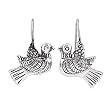


4. Cajeta de Mexico - This thick, paste-like dark syrup, made from caramelized sugar and milk (traditionally goat's milk), is perfect by itself or as topping for cereals, yogurt, fresh fruit, fried bananas and authentic Mexican desserts. Also good in the form of delicious candies, hard or soft, or caramel spread.

5. Achiote Paste - This is a popular blend of spices firmly associated with Mexican cuisine, especially that of Yucatán and Oaxaca. The spice mixture usually includes annatto, oregano, cumin, clove, cinnamon, black pepper, allspice, garlic, and salt. The annatto seeds give it a distinctive red color, adding to the food a hue of orange. When mixed with lemon juice, water, oil, or vinegar, the paste is used to marinade meat or be rubbed straight on it and then grilled, baked, barbecued, or broiled. Sometimes, the mixture is added to corn dough to create a zesty flavor and color in empanadas and red tamales.




6. Handmade Hammocks - Hand-woven by Mexican artisans in accordance with centuries-old tradition of craftsmanship, these comfortable hammocks will envelop your body for ultimate comfort and serve you for years. Highly durable, holding up to 550lbs, the hammocks are great for naps, siestas or even all night sleep! Just stretch yourself lengthwise or lay horizontally for a desired level of comfort and take a snooze.





7. Dried Chilies - Arbol, Pasilla Negro (“little black raisin”), and Cascabel chilies are staple ingredients for authentic Mexican recipes, such as tostadas, burritos, tacos, quesadillas and enchiladas, as well as tamales, salsa, chili, meats, soups, stews and BBQ. Hand-selected from the finest spice purveyors and chili growers in Mexico, these dried peppers should be at hand whenever you wish to go big on heat and flavor. Fantastic addition to any number of moles, salsas, and adobos. Combined with fruits, mushrooms, garlic, fennel, honey, or oregano, they are excellent with duck, seafood, or lamb.

